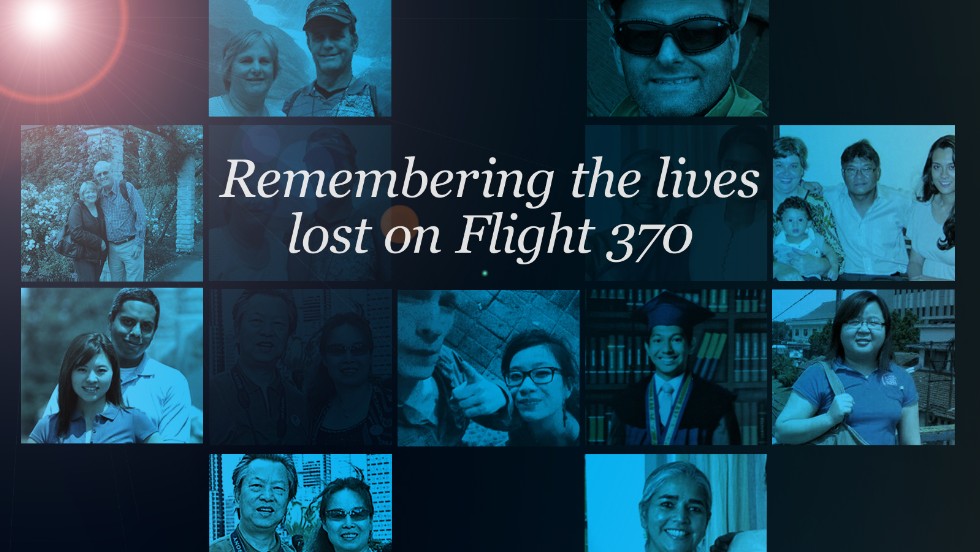Personally I believe the Captain did it (Ed.)
MH370: Did the pilots do it?
MH370: Two years later 02:37
Story highlights
- There are two main views for the disappearance: mechanical fault or a pilot gone rogue
- In most pilot suicide cases, potential reasons are uncovered quickly
Richard Quest is CNN's Aviation Correspondent and author of "The Vanishing of Flight MH370," a new book that examines the flight's disappearance, two years on. The opinions in this commentary are his.
(CNN)Two years after MH370 went missing and key questions remain unanswered: Where is the plane and what happened in the cockpit in the early hours of March 8, 2014?
Amid the conspiracy theories, there are two main views on what might have happened.
The first suggests that the captain hijacked the plane and flew it with all 238 other people on board to their deaths by crashing in the southern Indian Ocean.
The second view, and the one to which I subscribe, is that there was some form of mechanical fault.
Under that scenario, the pilots tried to get back to safety in Malaysia, but became incapacitated and the plane flew on; or that the pilots are heroes, and knowing they were doomed, set a course to avoid ground casualties and died after the plane crashed.
The simple, short answer as to which is true: we don't know. Anyone who tells you they do know is, frankly, making it up.
Rogue pilot?
The pilot theory pins the probable blame on 53-year old captain Zaharie Shah. I don't agree for a variety of reasons.
Pilot suicide is incredibly rare. When it happens it is shocking and deeply troubling for the traveling public. The most recent of course was the horrible crash of Germanwings 9525 in March 2015, where the first officer, Andreas Lubitz locked the captain out of the cockpit, then reset the autopilot altitude to 100 feet sending the plane crashing into the French Alps.
Whether premeditated (as the evidence shows with Germanwings) or on the spur of the moment, the deranged mind doesn't spend hours carefully plotting flight plans, working out how to disconnect every communication tool on the aircraft, then flying elaborate routes around countries ostensibly to avoid military radars. No -- they take over the aircraft and crash the plane. MH370 doesn't fit this pattern. And so far I can't find any case that would suggest it does.
With pilot suicide cases, we tend to find out the potential reasons relatively quickly. With Germanwings, we found out almost immediately the psychological and medical issues suffered by Lubitz. He had been doctor shopping in the weeks before the crash, visiting numerous general practitioners, psychologists. He had ripped up sick notes in his apartment and had been researching online suicide methods and the locking mechanism of the cockpit door.
Insufficient evidence
With MH370, we have no real evidence. None whatsoever. We have a few rumors, a bit of gossip and a few circumstantial facts which some wish to string together to make a case against the pilots.
Let us not forget Captain Zaharie had been a pilot with Malaysian airlines since 1981. He was a captain on the 777 for more than 15 years. He was exceptionally experienced -- a training captain -- who had been paired with 27-year-old first officer Fariq Ab Hamid. Hamid was transitioning to the 777 fleet and this was one of his first 777 flights out of the simulator on the real metal. Hamid was engaged to be married to a pilot at another airline.
The Factual Report published on the first anniversary of the plane's disappearance actually goes so far as to dismiss these accusations. It says, "the captain's ability to handle stress at work and home was good. There were no significant changes in his life style, interpersonal conflict of family stresses."
I am not naïve and obviously can see that the Malaysians might want to put the "best face on" to protect the reputation of their country's pilots. But we have to take the report at face value -- it's all we have on the record.
In the absence of that hard evidence, alternative theories flourished, bolstered by rumors. Like how the captain circled his home island of Penang for "one last look," or how the plane flew at different altitudes and routes to avoid radar. These make good yarns but aren't true.
There was no circling of Penang and there was no major change in altitude -- the Malaysian radar turned out to be wrong. These theories were all debunked by the Australian Transport Security Bureau in a rebuttal to Australian veteran pilot Byron Bailey who argues for the "rogue pilot" theory.
Also, the plane was spotted by Thai radar, which ignored it because it wasn't relevant. Finally, never forget that the plane was spotted by the Malaysian military as it flew across the country on that fateful night but was also ignored. A rogue pilot couldn't have banked on the failure of an oblivious radar operator not to scramble jets to see what was going on.
I shall leave it to others to make the case against the pilots on technical grounds. But we must stick to the facts.
The fact is there is no evidence to say the pilots did this.
Before I am prepared to convict a lifelong captain or a newbie first officer of hijacking a plane and killing 238 other people, I want more than a few odd rumors, a lot of scurrilous gossip and a heap of poor arguments. I am prepared to be proved totally wrong. Until such time I am not prepared to say "it was the pilot that did it."






Ingen kommentarer:
Legg inn en kommentar
Merk: Bare medlemmer av denne bloggen kan legge inn en kommentar.